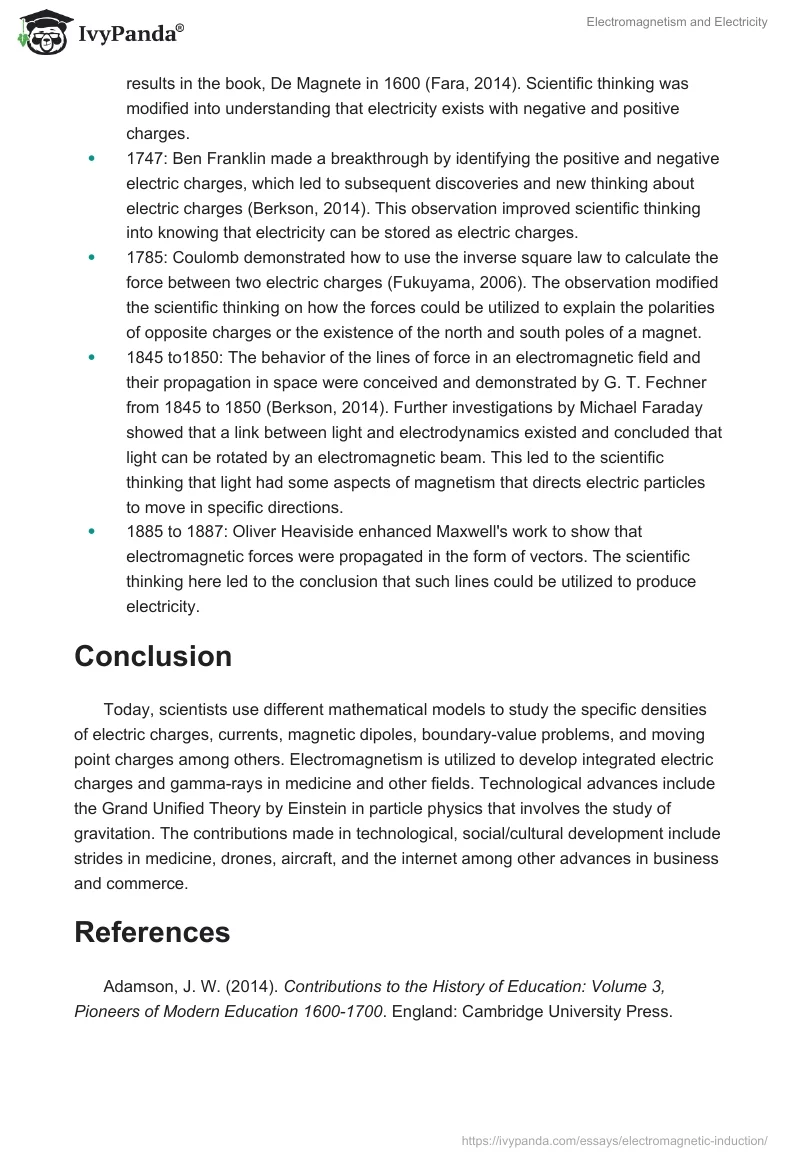Introduction
Discoveries linking electromagnetism with electricity led to the phenomenal changes that were witnessed in the field of physics and electrical engineering (Berkson, 2014). Unifying theories of magnetism with electricity were established in the eighteenth and nineteenth centuries by Law, Faraday (Faraday’s law), Henry, and Maxwell (Fara, 2014).
Electromagnetism is the study of the forces between electric charges and magnetic fields (Berkson, 2014). Coulomb’s laws of electromagnetism occur as vector and scalar quantities with magnitude and direction (Yoshizaki & Kageyama, 2014).
Historical events or discoveries
- 1600: The article on ‘De Magnete’ was published by William Gilbert (Berkson, 2014).
- 1747: Ben Franklin demonstrated the discovery of positive and negative charges (Adamson, 2014).
- 1785: “Coulomb’s law, which shows that the relationship between two charged particles is a function of the square of the distance between the charged particles, was published by Charles Austin de Coulomb” (Berkson, 2014, p. 3) as the inverse square law.
- 1845 to 1850: “G. T. Fechner verified Lenz’s law by using the relationship between Ampère’s law and Faraday’s law” (Berkson, 2014, p.4).
- 1885 to 1887: Oliver Heaviside used complex mathematical relationships to show the behavior of the lines of electromagnetic forces and how they were propagated in space (Warnick & Russer, 2014).
Annotated Timeline
- 1600: William Gilbert was conducting various experiments for 18 years by testing various electrical and non-electrical materials and concluded by writing the results in the book, De Magnete in 1600 (Fara, 2014). Scientific thinking was modified into understanding that electricity exists with negative and positive charges.
- 1747: Ben Franklin made a breakthrough by identifying the positive and negative electric charges, which led to subsequent discoveries and new thinking about electric charges (Berkson, 2014). This observation improved scientific thinking into knowing that electricity can be stored as electric charges.
- 1785: Coulomb demonstrated how to use the inverse square law to calculate the force between two electric charges (Fukuyama, 2006). The observation modified the scientific thinking on how the forces could be utilized to explain the polarities of opposite charges or the existence of the north and south poles of a magnet.
- 1845 to1850: The behavior of the lines of force in an electromagnetic field and their propagation in space were conceived and demonstrated by G. T. Fechner from 1845 to 1850 (Berkson, 2014). Further investigations by Michael Faraday showed that a link between light and electrodynamics existed and concluded that light can be rotated by an electromagnetic beam. This led to the scientific thinking that light had some aspects of magnetism that directs electric particles to move in specific directions.
- 1885 to 1887: Oliver Heaviside enhanced Maxwell’s work to show that electromagnetic forces were propagated in the form of vectors. The scientific thinking here led to the conclusion that such lines could be utilized to produce electricity.
Conclusion
Today, scientists use different mathematical models to study the specific densities of electric charges, currents, magnetic dipoles, boundary-value problems, and moving point charges among others. Electromagnetism is utilized to develop integrated electric charges and gamma-rays in medicine and other fields. Technological advances include the Grand Unified Theory by Einstein in particle physics that involves the study of gravitation. The contributions made in technological, social/cultural development include strides in medicine, drones, aircraft, and the internet among other advances in business and commerce.
References
Adamson, J. W. (2014). Contributions to the History of Education: Volume 3, Pioneers of Modern Education 1600-1700. England: Cambridge University Press.
Berkson, W. (2014). Fields of Force: The Development of a World View from Faraday to Einstein. London: Routledge.
Fara, P. (2014). Sympathetic attractions: magnetic practices, beliefs, and symbolism in eighteenth-century England. New Jersey: Princeton University Press.
Fukuyama, F. (2006). The end of history and the last man. New York, NY: Free Press.
Warnick, K. F., & Russer, P. H. (2014). Differential forms and electromagnetic field theory. Progress In Electromagnetics Research, 1(148), 83-112.
Yoshizaki, K. I., & Kageyama, A. (2014). Interactive timeline for vector field visualization. Memoirs of the Graduate Schools of Engineering and System Informatics Kobe University, 1(6), 25-28.


